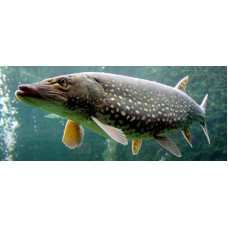Esocidae is a family of fishes in the family Salmoniformes. They have a pronghorn body. The scales are small and elongated. The dorsal and anal fins are carried well back. The mouth is large with many teeth. The snout is elongated and flattened from top to bottom, with a slightly protruding lower jaw. On the upper jaw, the scolex, palate and needle-like teeth of the tongue are directed backwards; on the lower jaw, the teeth are strong and fanged. The posterior edge of the upper jaw is free. Caudal fin notched or truncated. Length up to 1.3 m, weight up to 35 kg. Freshwater fish found in the waters of Europe, Asia and North America. Includes 5 species belonging to the same genus - Esox. Occupies slow flowing waters with developed vegetation. Spawns in spring on flooded, soft banks of rivers and lakes, incubating eggs on last year's vegetation. Predators. Commercial fish. Bred in ponds and lakes.
Esocidae have a modification of the canines on the lower jaw. The inner surface of the lower jaw is covered with soft tissue, beneath which are oblique rows of 2-4 replacement teeth adjacent to each canine, together forming a single group (family). When a working tooth is lost, a neighbouring replacement tooth from the same family takes its place with its base. At first it wobbles, then it becomes firm and grows close to the underlying bone. The teeth do not change at the same time. At the same time, some families end at the edge of the jaw with an old, resorbed tooth, others with a strong, working tooth, and others with a tooth that has not yet become strong, young, recently put to work. Similar tooth conditions are observed at different times of the year. At this time, Esocidae avoid taking large prey.
Esocidae spawn at a temperature of 3-6°C, immediately after the ice melts, near the shore at a depth of 0.5-1 m. They come out of shallow water and splash noisily during spawning. During spawning they move to shallow water and splash noisily. Usually the smallest fish approach first, then the medium and large fish. It is very accessible during the spawning season. Hold Esocidae at this time usually in groups: 2-4 males around a female, and around large females and up to 8 males. The males are always smaller than the females. The female swims in front, the males follow her, trailing half the length of her body. They are either pushed by the sides of the female or try to stay just above her back. The dorsal fins and part of the back are constantly out of the water. Esocidae rub against bushes, stumps, hornwort stems and other objects. Fish do not stay in one place for long and are constantly moving around the spawning grounds. This is the time when the eggs hatch. At the end of the spawning, all the individuals of the nest rush in different directions, causing a strong splash, with the males sometimes jumping to the surface of the water. A female lays between 17.5 and 215 thousand eggs, depending on her size. The eggs are large, about 3 mm in diameter, slightly sticky, strongly scattered by the female and stuck to vegetation, but they fall off easily when shaken. After 2-3 days the stickiness disappears completely, the eggs fall off and lie on the ground until the end of development. It is possible that sometimes eggs are deposited on the bottom at the same time. For example, in the Lena delta, at the beginning of the Bykovskaya canal, female and male pike were caught in a bay with a stony bottom where there was no vegetation at all.
Depending on the temperature, egg development takes 8-14 days. A sudden drop in temperature may cause the eggs to die. The hatched larvae are 6, 7-7, 6 mm long. With the resorption of the yolk sac, the larvae switch to feeding on external food: small crustaceans - cyclops and daphnia. Pike can catch carp larvae at the length of 12-15 mm. Carp usually spawn later than pike and their larvae are small enough to be caught by young pike. However, the transition to fish food at this size is not a natural phenomenon; young fish more often feed on larger invertebrates: larvae of chironomids, mayflies, water donkeys. When the pike reaches 5 cm, it switches almost completely to eating the young of other fish, mainly carps. If pike of this size are kept in an aquarium and fed small crustaceans, they will die because the energy expended in foraging for food is not replenished by the nutrients provided by the prey.
The transition of pike to predation at this size is an obligatory phenomenon. In alluvial reservoirs, which lost their connection with the river at an early stage, there are no young fish of other species after the recession of the hollows, and the feeding conditions for pike are extremely unfavourable. As a result, their growth is uneven, with large differences in length and weight between individuals. Large individuals can outweigh small ones by a factor of 2. Small individuals are available prey for large ones, and the latter feed on them willingly. Feeding on their own kind is called cannibalism. Sometimes pike as small as 3 cm are cannibalistic. Cannibalism usually occurs in larger pike of 10 cm or more.
The diet of Esocidae varies according to circumstances. They usually eat the most abundant fish. In lakes and reservoirs these are roach, perch, ruff, bream, gouster. In rivers, the food of Esocidae increases the importance of typical river fish - gudgeon, char, minnow, pinch, goby podkamenshchik, etc. In spring Esocidae hunt typical river fish. In spring Esocidae like to eat frogs. There are known cases when they have dragged mice, rats, waders and even squirrels across rivers into the river depths.
Esocidae
Tags: esocidae



